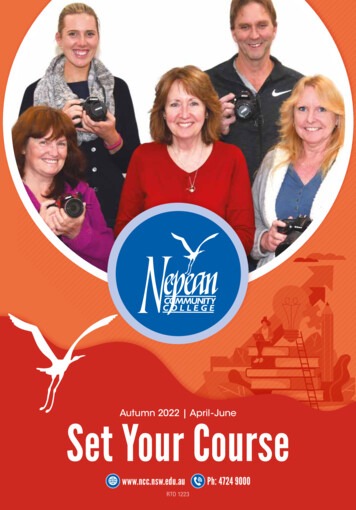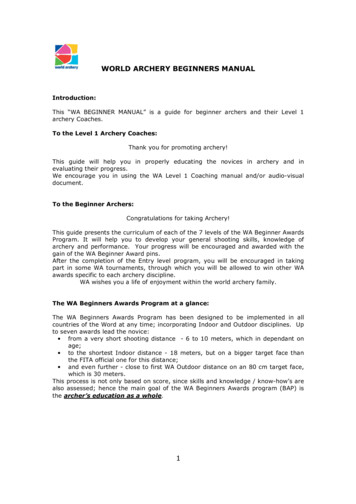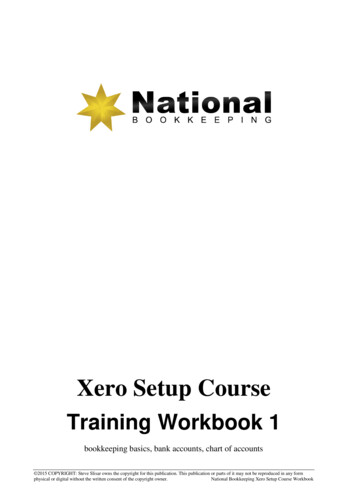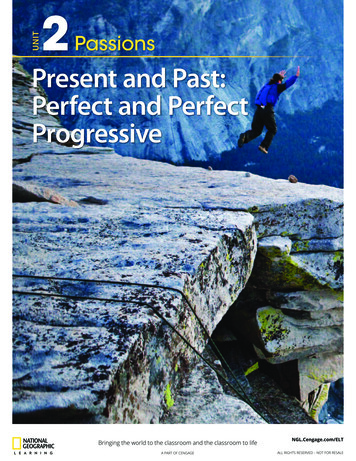
Transcription
401.331.0000support@homeschoolpiano.comBOOK 1 PERFECT FOR BEGINNERSDesigned for the absolute beginner to the piano, featuring six original pieces that are fun to play and practice.You’ll learn how to read music, improvise and create your own music. Each unit improves your piano skills withgraded quizzes.UNIT 1Technique: The grab technique, learning how to properly curl your fingers. C minor 5-finger scale.Rhythm: Quarter notes, quarter rests and half-note vocalizations.Reading/Song: Dynamics piano, mezzo-forte and forte. Legato vs. Staccato articulation. Slurs vs. ties.Guideposts C, F and G.Improvisation: What is improvisation? Licks and motifs. 3 licks based off of known rhythms andnotes C and Eb.Bonus: F major 5-finger scale, complete F major scale. F major and minor triads.UNIT 2Technique: C 5-finger major and minor scales hands together. Continuous 5-finger scale (crossingbetween the hands). Controlling dynamics.Rhythm: Dotted notes explanation. Dotted half-note. Half rest.Reading/Song: Stepping on the staff. Finding notes around your guideposts. Mezzo-piano dynamic.Crescendo. Longer song form and more interaction between the hands. Preparing your fingers tobe ready to play, incomplete measures.Improvisation: Creating melody vs. chords. Using chords in your improvisation. Writing musicwithout a staff. Improvising using notes C, D and Eb.Bonus: Focus on accompaniment. Introducing the steady bassline with simple licks in the right hand.UNIT 3Technique: 5-finger C minor scale with left hand accompaniment.Rhythm: Introducing eighth notes (dee-ba’s).Reading/Song: Whole note rhythm. Introducing ties. Root-5 (R5) left-hand chord pattern. Staccatoarticulation. F-clef G note “the ground” and G-clef F note “fly away.”Improvisation: Preparing the C minor pentatonic scale. Incorporating eighth notes into ourimprovisation. Improvising using notes C, Eb, F and G.Bonus: The full C minor pentatonic scale and scale blocks. 2014 HomeSchoolPianoTMJAZZEDGE 63 Cedar Ave. Unit 11 East Greenwich, RI 02818HomeSchoolPiano.com
401.331.0000support@homeschoolpiano.comUNIT 4Technique: 5-finger C blues scale with drums hands together, in contrary motion and witha bassline.Rhythm: Introducing the eighth note rest vocalization “uh.”Reading/Song: Steady bassline accompaniment. Term similie.Improvisation: Creating licks with the partial C minor pentatonic scale and C 5-finger blues scale.Bonus: Improvising over the steady bassline. 3 improvisation exercises.UNIT 5Technique: C major scale hands together. C blues scale with bassline.Rhythm: Syncopated rhythm, dee ba– ba.Reading/Song: New bass accompaniment pattern in C major.Improvisation: Licks from rhythmic blocks.Bonus: C major pentatonic scale and lick. C major scale with bassline accompaniment.UNIT 6Technique: A minor 5-finger scale. A major triad and 5-finger scale.Rhythm: Using the breath for an eighth rest.Reading/Song: New accompaniment bassline in A minor. Moving to a new key, A minor.Improvisation: Play licks along with bassline. Vocalize rhythm, then play lick.Bonus: Minor flowing piano pattern. 2014 HomeSchoolPianoTMJAZZEDGE 63 Cedar Ave. Unit 11 East Greenwich, RI 02818HomeSchoolPiano.com
401.331.0000support@homeschoolpiano.comBOOK 2 BUILDING A FOUNDATIONContinuing where Book 1 left off, you will continue working through rhythm, technique, music reading, songs andimprovisation. If you are coming to HomeSchoolPiano with some piano training under your belt, Book 2 is a greatplace to start.UNIT 1Technique: Focus on the left-hand bassline and left hand exercise. Building left hand fingerindependence.Rhythm: Finding upbeats within the measure.Reading/Song: New C major bassline accompaniment pattern. First and second endings.Improvisation: Melodic and rhythmic embellishment over new bassline pattern.Bonus: Improvisation over major and minor bassline pattern using pentatonic fragments, notesfrom the melody. C major and minor triads. Sliding between notes to create a bluesy sound.UNIT 2Technique: Left hand oom-pah accompaniment pattern. Broken chords.Rhythm: Three different ways to write out a syncopated dee ba– ba rhythm.Reading/Song: Oom-pah accompaniment pattern. C two-octaves below middle C.Improvisation: Breaking up chords C, F and G for improvisation.Bonus: Mixing together songs Little Willie’s Strut and Blues For You. Mash-ups.UNIT 3Technique: Full C major scale. Blocking technique for the major scale.Rhythm: Mixed syncopated rhythms.Reading/Song: Mixed accompaniment patterns: triads, bassline and omm-pahs. New chords Dmin,A and G7 (dominant 7th chords).Improvisation: Improvisation over triads. Introduction of form.Bonus: Creating a contemporary arrangement using chords in the right hand and octaves in the left. 2014 HomeSchoolPianoTMJAZZEDGE 63 Cedar Ave. Unit 11 East Greenwich, RI 02818HomeSchoolPiano.com
401.331.0000support@homeschoolpiano.comUNIT 4Technique: 5-finger scale A minor and blues scales.Rhythm: Alternating between left and right hand syncopated rhythms.Reading/Song: New minor bassline accompaniment. Chord symbols Amin7, F7 and E7.Improvisation: Introduction of A harmonic minor scale. Complete A blues scale. Concept of vampand improvisation springboards. Harmonic minor and blues scale blocks.Bonus: Call-and-response improvisation. Head-solo-head soloing.UNIT 5Technique: Different methods to create a triad. Inversions of triads. Arpeggiating triads.Rhythm: Alternating between left and right hand syncopated rhythms.Reading/Song: Triads and melody in the right hand. Active left hand bassline.Improvisation: Comping chords along with a steady bassline.Bonus: Improvising over the improvisation section bassline using licks and lines.UNIT 6Technique: R-5-R left hand patterns.Rhythm: Two-hand rhythms. Introducing style markings.Reading/Song: R-5-R accompaniment pattern. Moving between a minor and major key. Staccato lefthand. D.C. al Coda.Improvisation: D harmonic minor scale improvisation over R-5-R bassline.Bonus: Playing triads in inversions along with R-5-R bassline. 2014 HomeSchoolPianoTMJAZZEDGE 63 Cedar Ave. Unit 11 East Greenwich, RI 02818HomeSchoolPiano.com
401.331.0000support@homeschoolpiano.comBOOK 3 UNLOCKING THE PIANIST WITHINYou’ll learn how to create rich piano arrangements using the techniques in book 3. By incorporating original piecesin a variety of musical styles, book 3 helps you to become a well-rounded pianist, ready for the next challenge.UNIT 1Technique: All major and minor 5-finger scales in all 12 keys.Rhythm: Introducing triplets and their vocalization.Reading/Song: Finding chord symbols. Determine the root. Creating 5-finger scales and R5 diads.Improvisation: G blues scale broken into scale blocks. 2 new licks.Bonus: Changes to the accompaniment: R5 bassline, R7 chord shells. Improvisation over thecreated bassline.UNIT 2Technique: R5, R6, R7 chord arpeggios. R, 3, 5, 6 bassline.Rhythm: Style markings, triplets and syncopated rhythms.Reading/Song: R6 chords, R-3-5-6 bass pattern. 12-bar blues in G with bassline and chords.Improvisation: Blues notes, sliding and crushing. Creating blues licks over bass pattern.Bonus: More advanced bassline pattern. Play new pattern with melody and chords.UNIT 3Technique: R7 chord pattern with the octave in all 12 keys.Rhythm: Vocalizing rhythms that tie into other rhythms.Reading/Song: R7 chord shells. Creating a bassline from R7 shells.Improvisation: Complete F blues scale licks over R7 bassline. Breakdown of techniques used tocreate a 12-bar blues improvisation.Bonus: Comping 7th (block) chords in the right hand along with bassline. 2014 HomeSchoolPianoTMJAZZEDGE 63 Cedar Ave. Unit 11 East Greenwich, RI 02818HomeSchoolPiano.com
401.331.0000support@homeschoolpiano.comUNIT 4Technique: Broken triads C, F and G with rhythm in all inversions.Rhythm: Introducing subdivision method of rhythmic vocalization.Reading/Song: Montuno rhythmic pattern with quarter note and half note pulse; broken chordsand melodic phrases.Improvisation: 3 montuno patterns with half note bassline.Bonus: How to create your own montuno patterns.UNIT 5Technique: R-5-R patterns in the left hand. How to create a chord progression. Apply this new basspattern to a chord progression that you create.Rhythm: Subdivision of rhythms practice.Reading/Song: R-5-R bass pattern in a ballad style. How to use the pedal to create a legato sound.Improvisation: Introducing diatonic chords and how to create an improvisation using only the Fmajor scale. Roman numeral chord analysis.Bonus: Creating an active left and right hand pattern using R-5-R bass accompaniment and chordsin the right hand.UNIT 6Technique: Full triad arpeggios on D, A, Bmin and G. How to move the pinky with the rest of thehands for better technique.Rhythm: Subdivision of syncopated rhythms.Reading/Song: Introducing voice leading and moving between triads in inversions.Improvisation: Diatonic in the key of D. Analysis of the chords and creating an improvisation usingchord tones and the D major scale.Bonus: Congratulations, you’ve finished! Where to go from here using the material that you’vealready learned and resources to check out next! 2014 HomeSchoolPianoTMJAZZEDGE 63 Cedar Ave. Unit 11 East Greenwich, RI 02818HomeSchoolPiano.com
Continuing where Book 1 left off, you will continue working through rhythm, technique, music reading, songs and improvisation. If you are coming to HomeSchoolPiano with some piano training under your belt, Book 2 is a great place to start. Technique: Focus on the left-hand bassline and left hand exercise. Building left hand finger independence.











